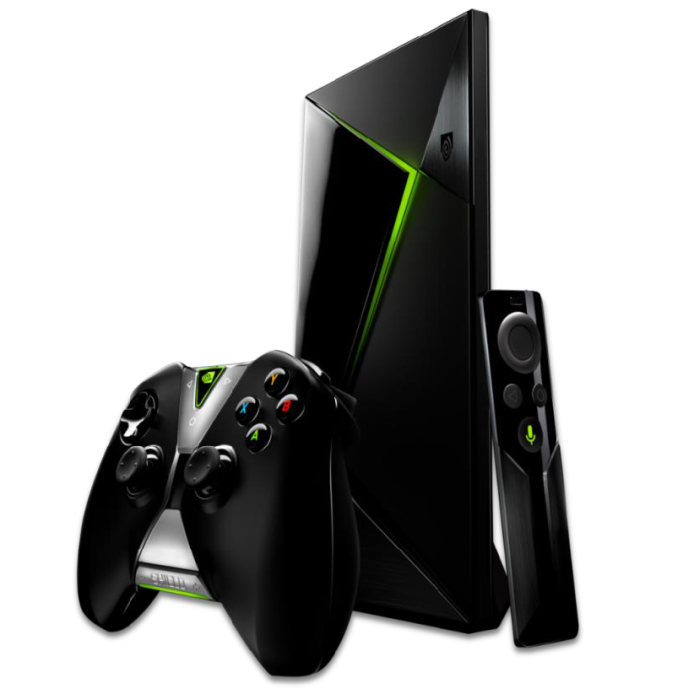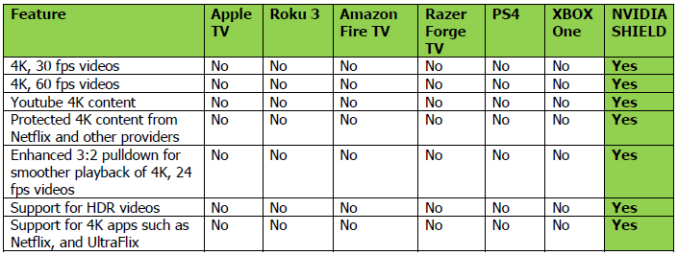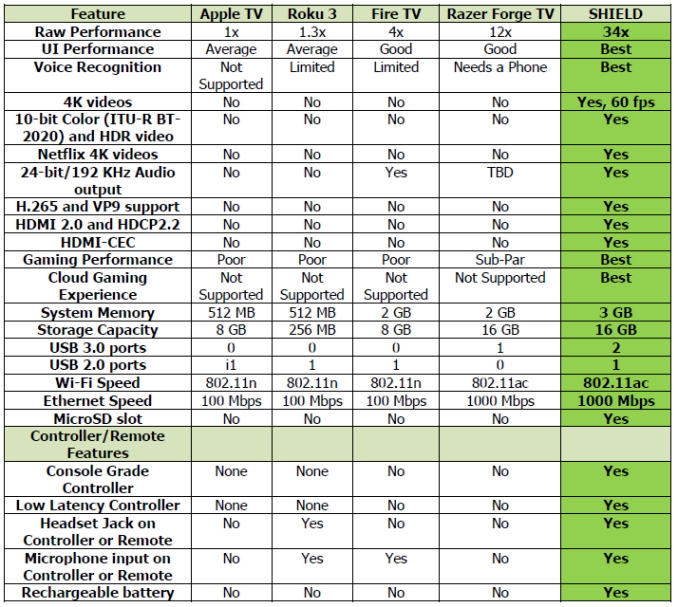The NVIDIA SHIELD Android TV Review: A Premium 4K Set Top Box
by Ganesh T S on May 28, 2015 3:00 PM EST- Posted in
- Media Streamer
- Home Theater
- TV
- 4K
- Shield
- NVIDIA

The battle for the living room (i.e, controlling the television experience) is heating up with forays from multiple vendors. As the cord-cutting trend gains momentum, the time seems to be right for disruption. Roku has been around for a long time and they continue to taste success with inexpensive and small over-the-top set-top boxes (OTT STBs). At the other end of the spectrum is the Apple TV, which, despite just being a 'hobby', has managed to move millions of units. Google had tried to make inroads into this market a few years back with the Google TV / Logitech Revue, but, it unfortunately didn't pan out as expected. Chromecast turned out to be more popular in their second attempt, but it was a limited play. In late 2014, Google launched Android TV along with the Nexus Player.
Coinciding with Google I/O, NVIDIA is releasing their previously announced SHIELD Android TV. First announed back in March at the 2015 Game Developers Conference, SHIELD Android TV is a premium 4K-capable over-the-top set-top box (OTT STB) with a powerful graphics engine. The differentiating aspects compared to the Intel Bay Trail-based Nexus Player and the Qualcomm Snapdragon-based Razer Forge TV lie in 4K support (HDMI 2.0 / HDCP 2.2 / Netflix 4K-certification) and excellent gaming credentials.
| NVIDIA SHIELD Family | ||
| NVIDIA SHIELD Tablet | NVIDIA SHIELD Android TV | |
| SoC | Tegra K1 (2.2 GHz 4x Cortex A15r3, Kepler 1 SMX GPU) | Tegra X1 (4x Cortex A57 + 4x Cortex A53, Maxwell 2 SMM GPU) |
| RAM | 2 GB LPDDR3-1866 | 3 GB LPDDR4-3200 |
| NAND | 16/32GB NAND + microSD | 16GB NAND + microSD + USB |
| Display | 8” 1920x1200 IPS LCD | N/A, HDMI 2.0 4Kp60 Output |
| Dimensions | 221 x 126 x 9.2mm, 390 grams | 210 x 130 x 25mm, 654 grams |
| Camera | 5MP rear camera, 1.4 µm pixels, 1/4" CMOS size. 5MP FFC | N/A |
| Battery | 5197 mAh, 3.8V chemistry (19.75 Whr) | N/A, 40W Power Adapter |
| OS | Android 5.0.1 | Android TV |
| Connectivity | 2x2 802.11a/b/g/n + BT 4.0, USB2.0, GPS/GLONASS, mini HDMI 1.4a | 2x2 802.11a/b/g/n/ac + BT 4.1/BLE, USB 3.0 + 2.0, HDMI 2.0 + HDCP 2.2, IR Receiver, Gigabit Ethernet |
| Launch Price | $299 (16GB/WiFi) + $59 (optional controller) | Basic: $199, Includes 1 SHIELD Controller Pro: $299, Adds 500GB Hard Drive |
The NVIDIA SHIELD smart TV platform comprises of three distinct products, the SHIELD console, the SHIELD wireless controller and the SHIELD remote.
The SHIELD is the main console, integrating a Tegra X1 SoC along with 3 GB of LPDDR4 DRAM and 16 GB of storage. I/O ports include two full-sized USB 3.0 host ports, a USB 2.0 micro-USB device port, GbE RJ-45 port, IR for universal remotes and 802.11ac 2x2 MIMO Wi-Fi with Bluetooth 2.1. It also includes a microSDXC slot. Video output is handled by a HDMI 2.0 port with HDCP 2.2 support.
The SHIELD Wireless Controller is the game controller bundled with the SHIELD console, and was first launched last year with the SHIELD Tablet. It uses Wi-Fi Direct for communication. A stereo headset jack and microphone are integrated. It also includes a rechargeable battery that can provide up to 40 hours of battery life.
Finally, the SHIELD Remote It is meant to be a replacement for the game controller in situations where single-handed operation is preferable. It uses Bluetooth for communication with the console. Like the game controller, a microphone and headset jack are included. The rechargeable battery is good for up to 4 weeks.
While the game controller and the console together retail in the basic package for $199, the SHIELD Remote is available separately for $50. Meanwhile after a slight snafu where it was announced back in April and then immediately pulled, NVIDIA is indeed offering a higher-end Pro SKU. SHIELD Pro model is similar to the SHIELD described above, except it adds an internal 500 GB hard drive into the mix and bundles a game - Borderlands: The Pre-Sequel! The Pro model is priced at $299.
Prior to diving into the details, let us take a look at the devices that NVIDIA is positioning the SHIELD Android TV against. Note that the two tables below are direct from NVIDIA's marketing material.
As we will see further down in the review, the above table is not far from the truth. In fact, except for NVIDIA claiming that their pulldown algorithm is enhanced compared to the competition, we tend to agree with everything. For the moment at least, NVIDIA pretty much has the 4K set top box to themselves.
NVIDIA claims a 34x raw performance increase compared to other OTT STB platforms. We won't endorse that particular number, but, in general, the performance of the SHIELD is miles ahead of the competition. The only other entry we find contentious is the availability of 24-bit / 192 KHz audio output. As we will see in the local media playback evaluation section, this is something of a moot point in most scenarios since the unit doesn't have licenses for decoding lossless HD audio. In any case, the above tables give an idea of where NVIDIA is positioning the SHIELD Android TV in the market.
The NVIDIA SHIELD Android TV also happens to be the first shipping product with the Tegra X1 SoC. We will first analyze the SoC and its performance in detail before moving on to Android TV in general and the SHIELD in particular.













167 Comments
View All Comments
testbug00 - Friday, May 29, 2015 - link
Nintendo can design a competent OS. The fact their OS runs smoother than Android did for years on Hardware that Android would choke on isn't really a negative.I'm not joking either, the sad part. And, why would the hardware force them to? Why would they risk people being able to pirate all their games super easy?
tipoo - Friday, May 29, 2015 - link
The 3DS, sure, modern android would choke on that hardware. But the design of getting around is still pretty byzantine. Anywho. The Wii U though? With 2GB RAM, half reserved for the OS, and three PowerPC750 based processor cores at 1.2GHz, the thing is still terribly slow for something released so recently. Meanwhile Android is butter with four low power Cortex A7 cores and does ok on 1GB RAM total.Not saying they should or shouldn't. And I'm not sure it would make piracy easier - even going with Android, being open source they can add their old security. Not that the Wii or DS were very secure from piracy either.
tipoo - Friday, May 29, 2015 - link
And what I mean by the 3DS bit...I picked up a 2DS from Target Canada while they were liquidating, half off so I thought what the hell. Didn't have much chance to use it until now.Went into street pass, there was an update available. Ok, go for it. Hit ok, confirm ok, yes it's ok it will take a while. Loads for a minute, then tells me I need to do a system update first. Figure out how to do that, easy enough. Start system update, confirm system update, yes it's fucking ok it will take a while. System update done.
Go back to streetpass plaza, start update. Hit ok, confirm ok, yes it's ok it will take a while. Connecting to online account. Cool. Takes a minute. Then tells me I don't have enough SD storage space. You couldn't check that first?! There's a message that tells me where to go to free storage. So, why can't there just be a button within the message that takes me there?
It could be because every time you close software, there's a button to really close it, and then a confirmation dialogue. Ach, getting real tired of your shit, Nintendo. A few more seconds of wait after you hit the *real* close button, too, because...I dunno. Nintendo.
Delete some crap. Go back to install the thing. Hit ok, confirm ok, yes it's ok it will take a while. Works this time. Go through the new Plaza to see what's new. Go through a bunch of dialogue with a talking rabbit just to see screenshots of each game. You can hold R, but it's still pretty slow.
Did I mention slow? The byzantine software layout may not even bug me as much if the thing was fast, but this is *really* slow. It's old hardware, I get that, plus it was low end hardware even at launch, but that doesn't stop it from being aggravating. The eShop being the worst of it. Going back and forth through pages is painstaking.
Some people have and probably will try to remind me that Nintendo is focused a lot on children. I honestly don't think even kids need all this padding though - this is the iPad generation, they'll get the hang of things in a jiffy, and don't need three confirmations from a talking dildo or whatever weird crap Nintendo wants to do every time they open or close software or after they've already said yes to a download.
Even with more attractive games on it than smartphones have, I find myself almost reluctant to use it every time for the slowness and very pre-iPhone software.
eanazag - Friday, May 29, 2015 - link
Nintendo just needs to give up on the hardware aspect and just distribute software. I would even pay for oldies like Excite Bike on iOS/MS Store/Google Play. I think they can still do regular consoles, but I have been disappointed with them. Good peripherals is still a market they could sell for.If anything, just sell the old stuff on those other services a make a dollar.
mkozakewich - Saturday, May 30, 2015 - link
If I were them, I'd work with a vendor to design a Nintendo Phone. Like, imagine an LG phone with Nintendo branding, a thumbstick, and four buttons? Maybe shoulder buttons, too. Whatever they could fit. (They might be able to get away with shoving all the usual 3DS buttons on.)smorebuds - Tuesday, June 2, 2015 - link
This is more what I was referring too. If Nintendo focused on releasing software (to the Android/iOS market where they'd make the biggest splash) then wouldn't a Nintendo set top box like this Shield make sense too? It would just be the Nintendo-branded and skinned Android box, maybe with some extra Nintendo-specific features thrown in.FMinus - Wednesday, June 3, 2015 - link
Why would they do that, I'm still pretty happy with my WiiU and their hardware offers something that noone else does, or usually copies it in one way or another. Besides Nintendo is sitting on a lot of cash, possibly more as Microsoft and Sony game divisions together anyway, so there's no fear of them going away anytime soon.Aside of that, they are the only company making consoles relatively affordable and kid friendly. Just as an example The Xbox/Playstation UI are an abomination to navigate for a 6 to 10 year old. And most importantly, Nintendo is focusing on games, not being the center of your living room, I'd gladly strip both the Xbox One and Playstation 4 of all the useless features (to me) if they offered them for $250.
stoicromance - Thursday, May 28, 2015 - link
So am I to understand that you can load pretty much any Google Play app onto this? Can I just throw VLC and Plex onto the Shield?Ryan Smith - Thursday, May 28, 2015 - link
Through the Play Store, an app needs to be flagged as supporting the 10ft Android TV UI in order to show up. Though you can sideload practically anything.ganeshts - Thursday, May 28, 2015 - link
Plex already comes pre-bundledVLC doesn't work that well right now on the SHIELD